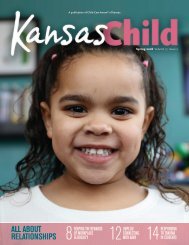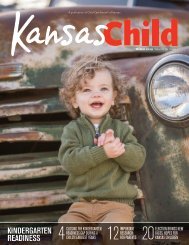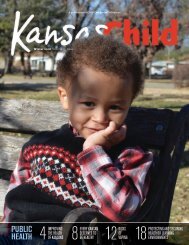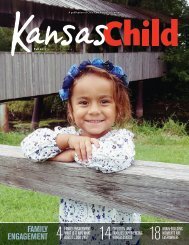Kansas Child Winter 2016
Kansas Child magazine is intended to provide a forum for the discussion of child care and early education issues and ideas. We hope to provoke thoughtful discussions within the field and to help those outside the field gain a better understanding of priorities and concerns. The views expressed by the authors are not necessarily those of Child Care Aware® of Kansas or their sponsors.
Kansas Child magazine is intended to provide a forum for the discussion of child care and early education issues and ideas. We hope to provoke thoughtful discussions within the field and to help those outside the field gain a better understanding of priorities and concerns. The views expressed by the authors are not necessarily those of Child Care Aware® of Kansas or their sponsors.
Create successful ePaper yourself
Turn your PDF publications into a flip-book with our unique Google optimized e-Paper software.
CHEYENNE<br />
SHERMAN<br />
WALLACE<br />
GREELEY<br />
HAMILTON<br />
STANTON<br />
MORTON<br />
WICHITA<br />
KEARNY<br />
GRANT<br />
STEVENS<br />
RAWLINS<br />
THOMAS<br />
LOGAN<br />
SCOTT<br />
FINNEY<br />
HASKELL<br />
SEWARD<br />
DECATUR<br />
SHERIDAN<br />
GOVE<br />
LANE<br />
GRAY<br />
MEADE<br />
NESS<br />
NORTON<br />
GRAHAM<br />
TREGO<br />
HODGEMAN<br />
CLARK<br />
FORD<br />
PHILLIPS<br />
ROOKS<br />
ELLIS<br />
RUSH<br />
PAWNEE<br />
EDWARDS<br />
KIOWA<br />
COMANCHE<br />
SMITH<br />
OSBORNE<br />
RUSSELL<br />
BARTON<br />
STAFFORD<br />
PRATT<br />
BARBER<br />
JEWELL<br />
MITCHELL<br />
LINCOLN<br />
ELLSWORTH<br />
RICE<br />
RENO<br />
KINGMAN<br />
HARPER<br />
REPUBLIC<br />
CLOUD<br />
OTTAWA<br />
SALINE<br />
MCPHERSON<br />
HARVEY<br />
SEDGWICK<br />
SUMNER<br />
WASHINGTON<br />
CLAY<br />
DICKINSON<br />
MARION<br />
BUTLER<br />
COWLEY<br />
MARSHALL<br />
POTTAWATOMIE<br />
RILEY<br />
GEARY<br />
MORRIS<br />
CHASE<br />
WABAUNSEE<br />
ELK<br />
NEMAHA<br />
LYON<br />
GREENWOOD<br />
JACKSON<br />
BROWN<br />
SHAWNEE<br />
COFFEY<br />
WOODSON<br />
DONIPHAN<br />
ATCHISON<br />
JEFFERSON<br />
DOUGLAS<br />
FRANKLIN<br />
ANDERSON<br />
ALLEN<br />
LABETTE<br />
CHAUTAUQUA<br />
MONTGOMERY<br />
JOHNSON<br />
MIAMI<br />
LINN<br />
BOURBON<br />
CHEROKEE<br />
able to achieve the level of quality that<br />
would best serve children. In these cases,<br />
the provider may need one-time funds to<br />
improve the quality of the center or home.<br />
Supporting family child care. Family<br />
child care homes are an absolutely essential<br />
part of the child care system and are key<br />
to addressing supply shortages, especially<br />
in rural areas or communities with a<br />
shortage of infant/toddler care. Supporting<br />
family child care providers and networks<br />
is an important part of supply building.<br />
Family child care providers are more likely<br />
to be isolated and have limited access to<br />
information, training, and resources on<br />
quality child care, so being proactive in<br />
our support of those providers should be a<br />
top priority.<br />
Payment rates and bonuses. For<br />
providers within the child care subsidy<br />
system, states can use higher payment<br />
rates, bonuses, or other financial incentives<br />
to make it more financial feasible to serve<br />
families in the CCDF program. With<br />
improved payment rates, providers might<br />
be more likely to be a part of the subsidy<br />
<strong>Child</strong> Care Referral Data<br />
system, which helps to stabilize the supply.<br />
These kinds of investments might also<br />
draw providers in to locations or types of<br />
care where demand is higher than supply.<br />
Community partnerships. <strong>Child</strong>ren<br />
have a wide variety of developmental<br />
needs, and one way to improve the quality<br />
of a child care setting is to create a strategy<br />
that addresses all of them. Building<br />
community partnerships and accessing<br />
local community or neighborhood-based<br />
hubs can add a new network of support for<br />
children, families, and child care providers.<br />
All families, including those who<br />
live in rural areas or who work nontraditional<br />
hours, deserve to have access<br />
to affordable, high-quality child care.<br />
We want all families across the country<br />
to know that addressing and alleviating<br />
shortages of quality child care is one of<br />
this administration’s highest priorities. I’m<br />
excited about the new focus and about the<br />
opportunities the CCDBG Act of 2014<br />
has given us. I can’t wait to see all of the<br />
ways we’re able to change the child care<br />
landscape for the better. •<br />
<strong>Child</strong> care referral requests for infant/toddler child<br />
care openings are in high demand<br />
3,200<br />
1,765<br />
1,603<br />
REGION ONE<br />
WILSON NEOSHO CRAWFORD<br />
Beyond the child:<br />
engaging parents in<br />
your child care program<br />
In early childhood, we focus much<br />
of our work on the children in care.<br />
<strong>Child</strong>ren are the reason that we do<br />
the job that we do, every day. A<br />
major component to making changes<br />
in children’s lives is including the<br />
family. In our work with providers, we<br />
challenge them to build a partnership<br />
and make the family just as much a<br />
part of the program as the children are.<br />
In the last year we worked with a<br />
provider who had a quality program<br />
and a passion to improve her<br />
interactions with parents. She attended<br />
our Strengthening Families trainings<br />
and learned about different ways to<br />
engage families. She received one-onone<br />
coaching from a specialist to help<br />
her develop plans to involve families.<br />
She started greeting families as they<br />
came into the program instead of<br />
having them just drop off the child at<br />
the door. She began having consistent<br />
parent cafes where the parents and<br />
the provider could get together and<br />
discuss important topics and share<br />
information. The provider felt more<br />
empowered at the end of the year, and<br />
she had additional ways for the families<br />
to be involved in the program.<br />
Under Age One<br />
Age One<br />
Age Two<br />
<strong>Child</strong> care referral requests for non-traditional shifts<br />
2nd Shift<br />
(evening)<br />
1,607<br />
3rd Shift<br />
(night)<br />
207<br />
Weekend<br />
1,307<br />
<strong>Child</strong> Care Referrals (completed by the <strong>Child</strong> Care Aware ® of <strong>Kansas</strong> Referral Center) January-September 2015<br />
www.ks.childcareaware.org <strong>Kansas</strong> <strong>Child</strong> 7
















